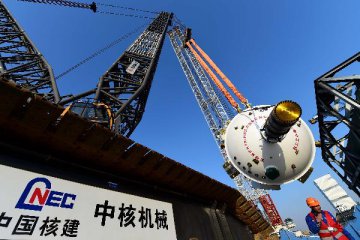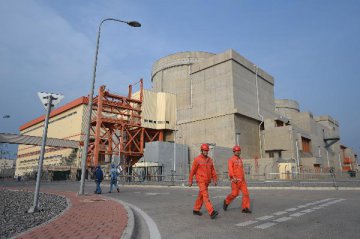
India and China are set to drive the world's nuclear power production growth as the two developing nations — among the top consumers of energy in the world — pursue their respective national nuclear energy programs.
According to the International Energy Agency, nuclear power production will grow by about 46 percent by 2040 — and more than 90 percent of the net increase will come from China and India.
Global nuclear electricity output grew 1 percent in 2017, as the world's nuclear fleet generated 2,503 terawatt-hours (TWh) of electricity, according to the World Nuclear Industry Status Report 2018.
Take China out of the picture, however, and the reality looks starkly different: Global nuclear power generation would have declined for a third consecutive year, the report showed.
Asia, for its part, saw 8 to 9 percent growth in nuclear capacity last year, Agneta Rising, the director general of the World Nuclear Association, told CNBC at the Singapore International Energy Week conference last week.
"(The) largest growth in nuclear energy is in the Asia region, especially in China and India," she said, adding that nuclear power is "absolutely compatible" and "necessary" for a low carbon future.
China dominates nuclear development
China added three new reactors to its fleet in 2017, bringing its total number of operating reactors to 41 — behind only the United States and France. The country reached its highest nuclear production that year, too: Its total output rose by a whopping 18 percent — or 35 TWh — the World Nuclear Industry Status Report showed.
China's expansion of nuclear production capabilities comes amid its push toward greater energy efficiency, a reduction of carbon intensity and a diversification away from fossil fuels, as outlined by the country's 13th Five Year Plan.
As part of that plan, Beijing is aiming to increase nuclear capacities to a total of 58 gigawatts (GW) by 2020. Its current nuclear capacity of 34.5 GW is, however, still dwarfed by renewable sources of energy such as wind and solar power — which are less costly, cleaner and safer to operate.
'Largest nuclear plant in the world'
With 22 nuclear reactors, India has the seventh-largest nuclear production fleet in the world, according to numbers from the International Atomic Energy Agency.
India's total net electrical capacity of 6,255 MW trails behind China's 42,800 MW. But as the rules for foreign firms operating nuclear facilities in India ease, the country's largely indigenous nuclear program is starting to open up. That could change the nuclear landscape in the South Asian country.
With a shortage of fossil fuels, India is pursuing nuclear investments as an alternative to add to the country's energy mix to power the country's development.
Rapid development of nuclear capabilities comes after years of exclusion from trade in nuclear materials and technology, which was a result of the country's non-signatory status to a 1970 treaty on nuclear non-proliferation. A civil liability law — which allows for unlimited legal recourse to nuclear operators up to 80 years following any nuclear accident — has further hampered international investment and cooperation.
Globally, nuclear energy capacity looks set to increase as part of countries continue to ramp up efforts to decarbonize.
"We see a large growth in nuclear energy around the world. In 2018, 2019 we will have more reactors coming online than it has been in the last 30 years," said the World Nuclear Association's Rising.





















Latest comments